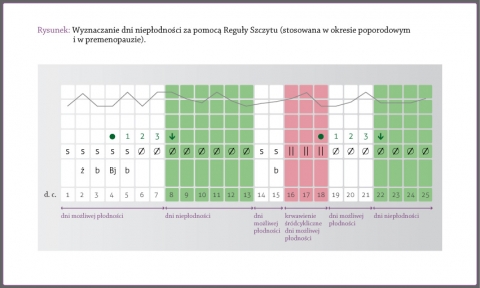
Pre-menopause (the period before menopause, the last menstrual period in life) is a natural stage of every woman’s life. It is a time of slow finishing the activity of ovaries and gradual disappearance of fertility.
- During the pre-menopause the cycles can be: shortened, with a short progesterone (corpus luteum) phase, or prolonged, with a length of 40, 60 or even 90 days, due to the prolonged estrogen phase (follicular phase disturbances).
- There are very often anovulatory, single phase cycles. The temperature chart can be irregular, with bouncing temperature
- To determine the periods of infertility during the pre-menopause we use the peak rule - infertile phase begins on the fourth evening after the cervical mucus peak, we don’t use any calculation rules
- In the period of menopause mucus can be: stingy, hard to observe, with less fertile features, difficult to observe the peak symptom, but it can also remain unchanged in appearance.
- Changes also occur within the cervix itself: it remains closed, dry and lowered.
During the pre-menopause the menstrual cycles are irregular due to finishing the activity of ovaries and thus reducing the level of produced hormones - estrogens and progesterone.
The first stage may be shortening of the higher temperatures (progesterone) phase caused by a faster decline in the level of progesterone than estrogens. The consequence of higher temperatures phase shortening is the cycle length shortening. Then one can observe the lengthening of lower temperatures (estrogen) phase due to lowered sensitivity of ovarian follicles to the FSH. Poor growth of follicles is correlated with the low level of estrogens in blood which causes additional stimulating of that growth by the pituitary gland through increased secretion of FSH. The strong increase of FSH causes the growing of a few follicles which leads to the increase in estrogens level. During the menstrual cycle there are several days with fertile type of mucus or intermenstrual bleeding and follicular (lower temperatures) phase is extended causing a lengthening of the cycle. However, the full maturation of the follicle and ovulation are quite rare.
During the pre-menopause it is worth to consider using herbal preparations based on chasteberry, which are used to treat irregular menstrual cycles and they can ease the premenopausal period symptoms and regulate the hormonal system.
After 40 years of age, when you find that your cycles have become irregular or single-phase ones, you should carry out your self-observations very carefully. To determine the absolute phase of infertility in premenopausal period you can apply the same rule as in breast-feeding – the peak rule. It is based on the determination of cervical mucus peak and waiting for four days. The evening of the fourth day is the beginning of the period of infertility, providing that you do not observe any signs of fertility or increase of temperature. If you observe the appearance of the days with mucus secretion again, these days should be treated as the days of possible fertility, and thus you have to determine the peak once more and four days after it.
As a result of overstimulation by the pituitary FSH estrogens level may rise so high that the cells of the cervix will produce a fertile mucus or intermenstrual bleeding will appear. However, usually at the time of preceding the menopause the characteristics of the mucus secreted by the cervix become progressively worse, most often a less fertile mucus appears, and some women have moisture sensation only for a short time. In this case both of these symptoms should be treated as a day of the peak. The hormonal changes taking place in premenopausal period affect not only the cervical mucus, but also the cervix: is it usually closed, dry and lowered.
It should be noted that from time to time, however, the ovulation can take place and you will see the temperature rise on the chart. To determine the postovulatory infertility we can usually use the Rötzer’s method assumptions, which means waiting for the three higher temperatures occurring after the peak of mucus symptom, together with no other signs of fertility. However, there are women with normal biphasic cycles even after 50 years of age, but the conception of a child at this age is very difficult due to the reduced levels of estrogens and progesterone, which is necessary for the proper development of the pregnancy.
Be prepared for the occurrence of a very long lower temperatures phase, followed by a higher temperature phase delayed significantly, or …it may not occur anymore. When the distance between the bleeding gets longer, the symptoms of fertility will appear more and more seldom and the phases of higher temperatures will occur hardly ever, you should measure the levels of FSH in the blood. With the finishing the activity of ovaries FSH - follicle stimulating egg maturation - levels rise sharply. High values of this hormone confirmed several times at monthly intervals indicates that ovulation will not occur any longer.


